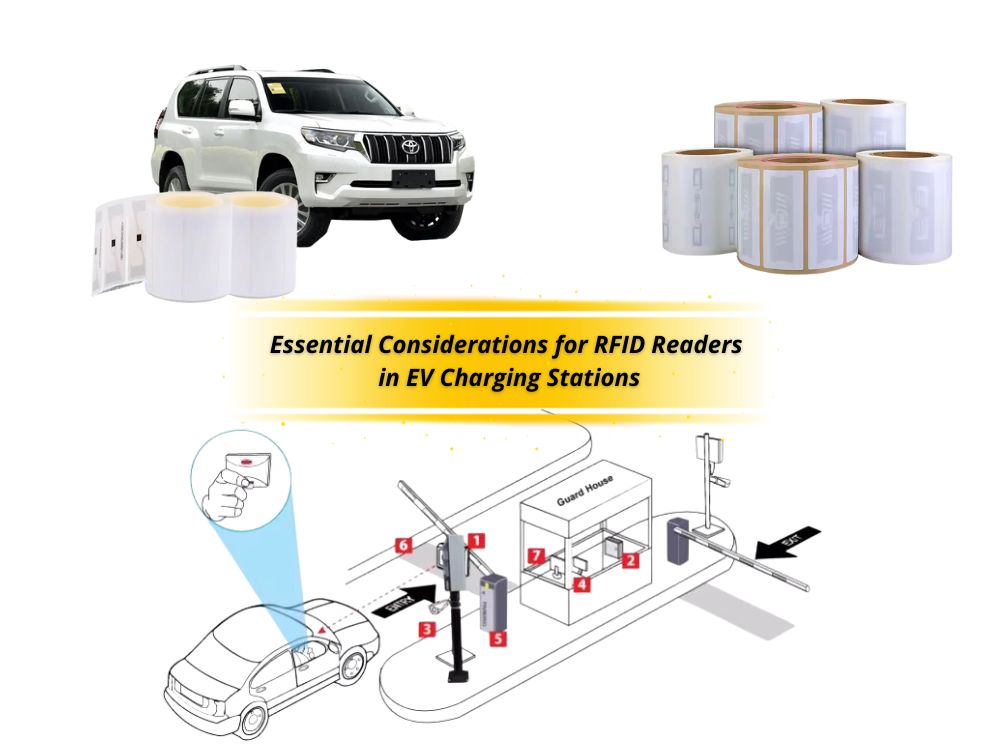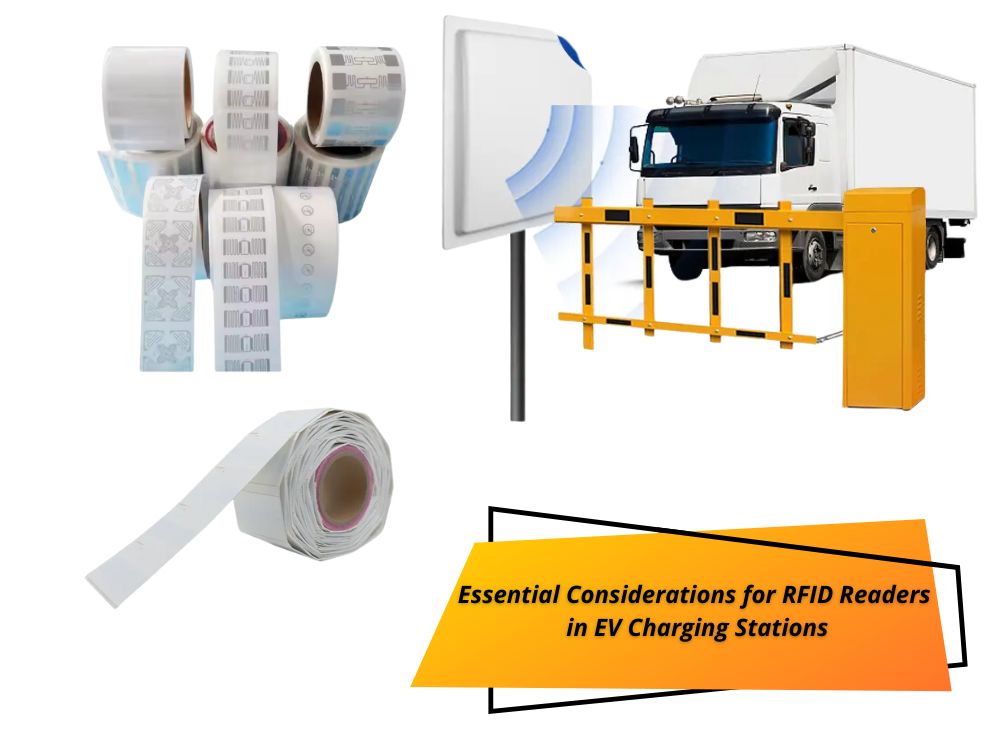
Essential Considerations for RFID Readers in EV Charging Stations
Table of Contents
How RFID Enhances Electric Vehicle Charging Infrastructure
RFID readers are becoming critical parts of EV charging stations. They offer contactless user authentication, access control, and seamless billing while improving operational efficiency and user experience.
In this article, we’ll explore why RFID is essential in EV charging stations, how it works, its key benefits, and what hardware solutions are ideal for your EV infrastructure projects.

Why RFID Technology Is Used in EV Charging Stations
EV charging stations, especially in public and semi-public environments, require a way to:
- Authenticate users
- Enable secure access
- Track energy usage
- Link charging sessions to billing accounts
RFID readers provide a simple and effective solution for all of the above. With a tap of an RFID card or NFC-enabled smartphone, drivers can activate a charging session, and operators can collect usage data and billing details without requiring complex logins or manual inputs.
How RFID Access Works in EV Charging Stations
The process is simple and user-friendly:
- User presents RFID card (or smartphone) to the reader embedded in the charger
- The RFID reader authenticates the user against a central database or local memory
- Access is granted, and the charging session begins
- The system logs energy consumption, duration, and user ID for billing/reporting
- Upon completion, the user may receive a receipt or see real-time app updates
This seamless process enhances EV charging networks’ speed, security, and traceability.
Key Benefits of Using RFID in EV Charging Stations
1. Secure Authentication
RFID ensures that only authorized users can activate a charging point. This is particularly important in:
- Private fleets
- Membership-based charging stations
- Smart cities and corporate campuses
RFID tags/cards are difficult to clone and can be encrypted for enhanced security.
2. Contactless, Hygienic, and Fast
In a post-pandemic world, contactless experiences are now expected. RFID readers enable tap-and-go charging, eliminating the need for buttons, apps, or PINs.
This speeds up access and improves hygiene — ideal for high-traffic public chargers.
3. Integrated Billing & User Identification
Each RFID card is tied to a user account or vehicle, enabling:
- Per-user billing
- Subscription-based models
- Loyalty program integration
- Charging history and analytics
This helps EV operators automate payment and reporting across networks.
4. Smart City & IoT Compatibility
RFID systems easily integrate with:
- Parking systems
- Access control
- Public transport RFID cards
- Fleet management dashboards
They support communication standards like Wiegand, RS485, or TCP/IP, making them perfect for interconnected smart infrastructure.
5. Durable Hardware for Outdoor Use
RFID readers designed for EV chargers are typically:
- Waterproof (IP65–IP68 rated)
- UV-resistant
- Tamper-proof
- Designed to operate in extreme temperatures
These rugged devices can be flush-mounted into charging stations or installed externally.
What Wireless Technologies Does the Reader Need to Support?
RFID readers must accommodate the diverse wireless technologies used by end-users. The choice of technology depends on whether users will access services via smartphones or membership cards, or both. Key RFID technologies include:
- Low-Frequency (LF) RFID (125 kHz):Generally used for proximity applications.
- High-Frequency (HF) RFID (13.56 MHz):Often used for more secure transactions and compatibility with NFC.
- Bluetooth Low Energy (BLE):Common in smartphones for proximity-based interactions.
- Near Field Communication (NFC):Allows for short-range communication between devices.
Technology | Frequency | Typical Use | Compatibility |
LF RFID | 125 kHz | Proximity access | Limited to specific tags |
HF RFID | 13.56 MHz | Secure transactions | Compatible with NFC |
BLE | 2.4 GHz | Smartphone access | Common in modern phones |
NFC | 13.56 MHz | Contactless payments | Integrated with HF RFID |
A multi-technology reader supporting LF, HF, BLE, and NFC provides flexibility to meet diverse user needs and future-proof your system.
Use Case: RFID in Smart EV Charging Networks
Leading EV networks across Europe and Asia use RFID to:
- Authenticate users via card or mobile wallet
- Link charging sessions to customer accounts
- Offer tiered access (public, members, corporate fleets)
- Enable smart billing and time-based pricing
- Manage multi-station networks with centralized control
RFID systems scale seamlessly from home chargers to nationwide EV fleets.
Selecting the Right RFID Reader for Your Charging Network
When choosing an RFID reader, ask:
- What tags or cards will users bring?
- Will readers need to support NFC or smartphones?
- Will you deploy the system internationally?
- Do you need waterproof or rugged enclosures?
- Will you upgrade the firmware or integrate APIs later?
A future-ready RFID solution balances performance, compliance, security, and user experience.

FAQs – RFID in EV Charging Systems
What is the role of RFID in EV charging stations?
RFID readers authenticate users by scanning their RFID card or tag. This ensures secure, contactless access to charging and links sessions to a user account.
Is NFC the same as RFID in EV charging?
NFC is a type of HF RFID and is commonly used in smartphones. Many RFID readers for EV chargers support both traditional cards and mobile NFC devices.
Can I integrate RFID readers with existing charging stations?
Yes — many RFID readers are designed with standard communication protocols and are compatible with most EV charger control boards.
Is RFID secure for public charging environments?
Yes — especially when using encrypted cards (like DESFire). RFID adds a layer of access control and user verification.
Ready to Power Up with RFID?
We supply RFID readers and tags designed for EV infrastructure—tested for performance, integration, and durability.
📩 Request a Free Quote or Consultation
📱 WhatsApp our RFID team: +86 138 2318 6864
- HF & NFC RFID modules
- Panel-mount and waterproof readers
- OEM support & custom encoding
- Global delivery available
Comments
Hot Products

What Is RFID Waste Management
Imagine a city where every trash bin speaks — not literally — but through a tiny chip that tells the system when it’s full, when it’s emptied, and where it went. That’s what RFID waste management is doing today.

What are Bolt Seals and their Applications? | Complete Guide
In global trade and logistics, bolt seals play a crucial role in ensuring cargo security and compliance. These small but powerful devices are designed to lock shipping containers, trailers, and cargo doors with a tamper-evident mechanism.

What is an RFID Card Protector? Benefits, Use Cases, and Buying Guide
RFID technology (Radio Frequency Identification) is everywhere: in your credit cards, ID badges, transit passes, hotel room keys, and more. It offers speed and convenience, but it also opens the door to a new kind of digital theft called “skimming.” That’s where an RFID card protector comes in.

RFID Wristbands for Events: Bulk Buying Guide for Organizers
RFID wristbands for events are becoming the go-to solution for organizers who need faster entry, fraud prevention, and cashless payments at concerts, festivals, and sports venues. Unlike paper tickets or QR codes, these smart wristbands use embedded chips to streamline access, secure transactions, and improve the guest experience.

How RFID Tag on Windscreen Improves Vehicle Access Control and Toll Systems
In today’s fast-paced world, vehicle identification needs to be quick, secure, and contactless. An RFID Tag on the Windscreen provides exactly that — a reliable way to manage toll collection, parking, and gated access without stopping vehicles.

The Benefits of RFID Linen Tags in Commercial Laundry
Managing laundry in hospitals, hotels, or large laundry services is a big job. Each day, thousands of sheets, towels, and uniforms are washed, sorted, and sent back out. But problems like lost linens, sorting mistakes, and manual counting can cost companies a lot of money. For example, mid-sized hotels can lose over $200,000 each year from missing linens.
That’s where RFID Linen Tags come in.
Tags
RELATED BLOGS

What Is RFID Waste Management
Imagine a city where every trash bin speaks — not literally — but through a tiny chip that tells the system when it’s full, when it’s emptied, and where it went. That’s what RFID waste management is doing today.

What are Bolt Seals and their Applications? | Complete Guide
In global trade and logistics, bolt seals play a crucial role in ensuring cargo security and compliance. These small but powerful devices are designed to lock shipping containers, trailers, and cargo doors with a tamper-evident mechanism.

What is an RFID Card Protector? Benefits, Use Cases, and Buying Guide
RFID technology (Radio Frequency Identification) is everywhere: in your credit cards, ID badges, transit passes, hotel room keys, and more. It offers speed and convenience, but it also opens the door to a new kind of digital theft called “skimming.” That’s where an RFID card protector comes in.




